Mitigating Human–Nature Tensions Through Adaptive Zoning Informed by the Habitat Suitability of Flagship Species: Insights from the Longbao Reserve on the Qinghai–Tibet Plateau
Abstract
1. Introduction
2. Materials and Methods
2.1. Study Area
2.2. Research Data
2.2.1. Flagship Species Monitoring Data
2.2.2. Acquisition and Processing of Environmental Variables
2.3. Methods
2.3.1. MaxEnt Model
2.3.2. Random Forest Model
2.3.3. Model Ensemble Strategy
2.3.4. Delineation of Refined Zoning
3. Results
3.1. Model Evaluation Results
3.2. Spatiotemporal Distribution of Habitat Suitability
3.3. Key Environmental Factors and Their Response Curves
3.4. Refined Management Zoning
- (1)
- Core Habitat Conservation Zones accounted for 16.9% of the study area. These zones were primarily located in undisturbed lakes and wetlands, exhibiting peak ecological suitability, with minor extensions into the margins of buffer zones. Collectively, these areas meet the habitat requirements of flagship species through optimal land cover, proximity to water, healthy vegetation conditions, and minimal anthropogenic disturbance.
- (2)
- Ecological Rehabilitation Zones comprised 7.2% of the study area. These were situated along the periphery of core zones and extended into buffer areas. Characterized by lower habitat suitability scores, they still fulfill the basic habitat needs of bar-headed geese and black-necked cranes. Well-developed vegetation and moderate levels of human pressure make these areas suitable for targeted ecological restoration.
- (3)
- Ecological Management Zones covered the largest proportion (53.5%) of the study area, mainly distributed across western experimental zones and southern buffer zones. These zones exhibited low-to-moderate habitat suitability, intermediate NDVI values, average vegetation coverage, and moderate habitat quality. Given their proximity to roads and settlements, they are appropriate for maintaining ecological continuity through disturbance mitigation measures.
- (4)
- Sustainable Utilization Zones accounted for 22.4% of the study area and were distributed across central experimental zones and peripheral buffer areas in the north and west. These areas are characterized by low vegetation cover, considerable distance from water bodies, and high levels of anthropogenic disturbance. Although they exhibit the lowest ecological suitability, they remain appropriate for controlled use and development under strict ecological safeguards.
4. Discussion
4.1. Suitability Distribution and Influencing Factors
4.2. Precision Zoning and Management Control
4.3. Limitations and Prospects
5. Conclusions
Author Contributions
Funding
Data Availability Statement
Acknowledgments
Conflicts of Interest
References
- Stephens, T. The Kunming–Montreal Global Biodiversity Framework. Int. Leg. Mater. 2023, 62, 868–887. [Google Scholar] [CrossRef]
- Wilson, T.S.; Matchett, E.; Byrd, K.B.; Conlisk, E.; Reiter, M.E.; Wallace, C.; Flint, L.E.; Flint, A.L.; Joyce, B.; Moritsch, M.M. Climate and land change impacts on future managed wetland habitat: A case study from California’s Central Valley. Landsc. Ecol. 2022, 37, 861–881. [Google Scholar] [CrossRef]
- Wang, S.; Yao, W.; Ma, Y.; Shang, E.; Zhang, S.; Chen, F.; Zeng, Y. Optimizing natural boundary definition and functional zoning in protected areas: An integrated framework encompassing species, landscapes and ecosystems. Glob. Ecol. Conserv. 2024, 49, e02781. [Google Scholar] [CrossRef]
- Luo, H.; Sun, G.; Zhou, W.; Lian, J.; Sun, Y.; Hu, Y. Promoting Rural Revitalization via Natural Resource Value Realization in National Parks: A Case Study of Baishanzu National Park. Land 2025, 14, 298. [Google Scholar] [CrossRef]
- Zeng, Q.; Zhang, Y.; Jia, Y.; Jiao, S.; Feng, D.; Bridgewater, P.; Lei, G. Zoning for management in wetland nature reserves: A case study using Wuliangsuhai Nature Reserve, China. SpringerPlus 2012, 1, 23. [Google Scholar] [CrossRef] [PubMed]
- Guiding Opinions on Establishing a Nature Reserve System with National Parks as the Main Body. Available online: https://www.gov.cn/zhengce/2019-06/26/content_5403497.htm (accessed on 18 June 2025).
- Li, Z.; Ma, L.; Chen, X.; Wang, X.; Bai, J. Zoning and management of ecological restoration from the perspective of ecosystem service supply and demand: A case study of Yuzhong County in Longzhong Loess Hilly Region, China. Land 2023, 12, 992. [Google Scholar] [CrossRef]
- Luo, X.; Le, F.; Zhang, Y.; Zhang, H.; Zhai, J.; Luo, Y. Multi-scenario analysis and optimization strategy of ecological security pattern in the Weihe river basin. J. Environ. Manag. 2024, 366, 121813. [Google Scholar] [CrossRef]
- Fu, M.; Tian, J.; Ren, Y.; Li, J.; Liu, W.; Zhu, Y. Functional zoning and space management of Three-River-Source National Park. J. Geogr. Sci. 2019, 29, 2069–2084. [Google Scholar] [CrossRef]
- Wei, D.; Feng, A.; Huang, J. Analysis of ecological protection effect based on functional zoning and spatial management and control. Int. J. Geoherit. Parks 2020, 8, 166–172. [Google Scholar] [CrossRef]
- Liu, X.; Wei, M.; Zeng, J. Simulating urban growth scenarios based on ecological security pattern: A case study in Quanzhou, China. Int. J. Environ. Res. Public Health 2020, 17, 7282. [Google Scholar] [CrossRef]
- Liu, Y.; Cao, W.; Wang, F. Spatiotemporal evolution of land cover and landscape ecological risk in Wuyishan National Park and surrounding areas. Land 2024, 13, 646. [Google Scholar] [CrossRef]
- Li, Z.; Zhu, J. Assessment and spatial partitioning of ecosystem services importance in Giant Panda National Park: To provide targeted ecological protection. PLoS ONE 2022, 17, e278877. [Google Scholar] [CrossRef]
- Ma, B.; Xie, Y.; Zhang, T.; Zeng, W.; Xue, Y. Construction of a human-wildlife spatial interaction index in the Three-River Source Region, China. Ecol. Indic. 2021, 129, 107986. [Google Scholar] [CrossRef]
- Ma, B.; Zeng, W.; Xie, Y.; Wang, Z.; Hu, G.; Li, Q.; Zhuo, Y.; Zhang, T. Boundary delineation and grading functional zoning of Sanjiangyuan National Park based on biodiversity importance evaluations. Sci. Total Environ. 2022, 825, 154068. [Google Scholar] [CrossRef] [PubMed]
- Li, C.; Yu, J.; Wu, W.; Hou, R.; Yang, Z.; Owens, J.R.; Gu, X.; Xiang, Z.; Qi, D. Evaluating the efficacy of zoning designations for national park management. Glob. Ecol. Conserv. 2021, 27, e01562. [Google Scholar] [CrossRef]
- Murillo, F.J.; Weigel, B.; Clark, D.; Kenchington, E. Hierarchical modelling of epibenthic communities on the Scotian Shelf and Gulf of Maine (Atlantic Canada) in support of conservation planning. Can. J. Fish. Aquat. Sci. 2024, 81, 12. [Google Scholar] [CrossRef]
- Li, H.; Zhou, B.; Wu, X. Characterization of spatial-temporal evolution of landscape ecological risk in the Three-River Source Region. J. Resour. Ecol. 2025, 16, 326–339. [Google Scholar]
- Xi, C.; Chi, Y.; Qian, T.; Zhang, W.; Wang, J. S Simulation of human activity intensity and its influence on mammal diversity in Sanjiangyuan National Park, China. Sustainability 2020, 12, 4601. [Google Scholar] [CrossRef]
- Zhou, X.; Huang, H.; Dai, S.; Zheng, D.; Zhao, J. Research on an ecological sensitivity evaluation of mountain-type national parks under multi-modal optimization: A case study of Shennongjia, China. Land 2025, 14, 923. [Google Scholar] [CrossRef]
- Song, X.; Wu, Y.; Chen, S.; Wang, L.; Yang, D.; Zhang, W.; Liu, N. A framework for functional zoning of national parks based on biocultural diversity assessment. Glob. Ecol. Conserv. 2024, 51, e02877. [Google Scholar] [CrossRef]
- Liu, J.; Huang, X.; Guo, H.; Zhang, Z.; Li, X.; Ge, M. Study on functional zoning method of national park based on MCDA: The case of the proposed “Ailaoshan-Wuliangshan” National Park. Land 2022, 11, 1882. [Google Scholar] [CrossRef]
- He, S.; Jiao, W. Adapting traditional industries to national park management: A conceptual framework and insights from two Chinese cases. J. Clean. Prod. 2022, 367, 133007. [Google Scholar] [CrossRef]
- Wang, Q.; Hu, Y.; Linsheng, Z.; Hui, W. Optimising the relationship between ecological protection and human development through functional zoning. Biol. Conserv. 2023, 281, 110001. [Google Scholar] [CrossRef]
- International Union for Conservation of Nature (IUCN). The IUCN Red List of Threatened Species. Available online: https://www.iucnredlist.org (accessed on 18 June 2025).
- National Forestry and Grassland Administration of China; Ministry of Agriculture and Rural Affairs of China. List of National Key Protected Wild Animals (2021). Announcement No. 3. Available online: https://leap.unep.org/en/countries/cn/national-legislation/announcement-2021-no-3-national-forestry-and-grassland (accessed on 18 June 2025).
- Zhang, J.; Xie, Y.; Li, L.; Batbayar, N.; Deng, X.; Damba, I.; Meng, F.; Cao, L.; Fox, A.D. Assessing site-safeguard effectiveness and habitat preferences of Bar-headed Geese (Anser indicus) at their stopover sites within the Qinghai-Tibet Plateau using GPS/GSM telemetry. Avian Res. 2020, 11, 49. [Google Scholar] [CrossRef]
- Duo, H.; Ji, H.; Yang, F.; Zhao, H.; Basang, C.; Ma, H. Diversity of Wetland Birds at Longbao National Nature Reserve. Wetl. Sci. Manag. 2022, 18, 33–37, (In Chinese with English Abstract). [Google Scholar]
- Ma, Z.; Li, F.; Li, P.; Xiao, J. The Dynamic Change Research of Ecological Environment in Longbao Region of Yushu State in Qinghai. Pratacult. Sci. 2009, 26, 6–11, (In Chinese with English Abstract). [Google Scholar]
- The State Council of the People’s Republic of China. Announcement by the National Forestry and Grassland Administration (China Added 18 New Sites to the List of Wetlands of International Importance). Available online: https://www.gov.cn/zhengce/zhengceku/2023-06/14/content_6888450.htm (accessed on 18 June 2025).
- Shi, F.; Zhou, B.; Yan, L.; Qiao, B.; Shi, M.; Chen, Q. Spatial–Temporal Variation Characteristics and Climate Driving Force Analysis of Longbao Alpine Wetland in Recent 32 Years. Plateau Meteorol. 2020, 39, 1282–1294, (In Chinese with English Abstract). [Google Scholar]
- Bibby, C.J.; Jones, M.; Marsden, S. Bird Surveys; Biology Department, Kenyon College: Gambier, OH, USA, 1998. [Google Scholar]
- Abolmaali, S.M.R.; Tarkesh, M.; Bashari, H.; Bashari, H. MaxEnt modeling for predicting suitable habitats and identifying the effects of climate change on a threatened species, Daphne mucronata, in central Iran. Ecol. Inform. 2018, 43, 116–123. [Google Scholar] [CrossRef]
- Fu, A.; Gao, E.; Tang, X.; Liu, Z.; Hu, F.; Zhan, Z.; Wang, J.; Luan, X. MaxEnt modeling for predicting the potential wintering distribution of Eurasian spoonbill (Platalea leucorodia) under climate change in China. Animals 2023, 13, 856. [Google Scholar] [CrossRef] [PubMed]
- Merow, C.; Smith, M.J.; Silander, J.A., Jr. A practical guide to MaxEnt for modeling species’ distributions: What it does, and why inputs and settings matter. Ecography 2013, 36, 1058–1069. [Google Scholar] [CrossRef]
- Nieto, S.; Flombaum, P.; Garbulsky, M.F. Can temporal and spatial NDVI predict regional bird-species richness? Glob. Ecol. Conserv. 2015, 3, 729–735. [Google Scholar] [CrossRef]
- Mukherjee, A.; Borad, C.K. Effects of waterbirds on water quality. Hydrobiologia 2001, 464, 201–205. [Google Scholar] [CrossRef]
- Mi, C.; Huettmann, F.; Guo, Y.; Han, X.; Wen, L. Why choose random forest to predict rare species distribution with few samples in large undersampled areas? Three Asian crane species models provide supporting evidence. PeerJ 2017, 5, e2963. [Google Scholar] [CrossRef]
- Xiang, H.; Mao, D.; Wang, M.; Wang, Y.; Choi, C.-Y.; Wang, W.; Wu, H.; Feng, K.; Wang, Z. Wetland key habitat functional areas in China informed by flagship waterbirds: The past change, present status and future trend with modeling scenarios. Geogr. Sustain. 2025, 6, 100284. [Google Scholar] [CrossRef]
- Phillips, S.J.; Dudík, M. Modeling of species distributions with MaxEnt: New extensions and a comprehensive evaluation. Ecography 2008, 31, 161–175. [Google Scholar] [CrossRef]
- Zhao, Z.; Xiao, N.; Shen, M.; Li, J. Comparison between optimized MaxEnt and random forest modeling in predicting potential distribution: A case study with Quasipaa boulengeri in China. Sci. Total Environ. 2022, 842, 156867. [Google Scholar] [CrossRef]
- Evans, J.S.; Cushman, S.A. Gradient modeling of conifer species using random forests. Landsc. Ecol. 2009, 24, 673–683. [Google Scholar] [CrossRef]
- Li, Y.; Wu, J.; Wang, H.; Sun, B.; Xu, M. Assessing the accuracy and stability of variable selection methods for random forest modeling in ecology. Environ. Monit. Assess. 2017, 189, 316. [Google Scholar] [CrossRef] [PubMed]
- Hu, H.; Wei, Y.; Wang, W.; Wang, C. The influence of climate change on three dominant alpine species under different scenarios on the Qinghai–Tibetan Plateau. Diversity 2021, 13, 682. [Google Scholar] [CrossRef]
- Julien, A.; Melles, S. Habitat suitability in the eyes of the beholder: Using random forest models to predict land cover type and scale of selection through avian functional traits. Diversity 2024, 16, 763. [Google Scholar] [CrossRef]
- Gao, M.; Fang, S.; Deitch, M.J.; Hu, Y.; Zhang, D.; Wan, Z.; He, P.; Pan, Y.; Gebremicael, T.G. Prioritizing birds’ habitats for conservation to mitigate urbanization impacts using field survey-based integrated models in the Yangtze River estuary. Land 2023, 12, 2115. [Google Scholar] [CrossRef]
- Wang, G.; Wu, H.; Dai, J.; Xiong, Y.; Long, Y.; Cai, X.; Mo, S.; Yang, R.; Liu, Y. Priorities identification of habitat restoration for migratory birds under the increased water level during the middle of dry season: A case study of Poyang Lake and Dongting Lake wetlands, China. Ecol. Indic. 2023, 151, 110322. [Google Scholar] [CrossRef]
- Almasieh, K.; Cheraghi, M. Habitat suitability, core habitats and diversity hotspots for the conservation of the mustelid species in Iran. Glob. Ecol. Conserv. 2022, 36, e02120. [Google Scholar] [CrossRef]
- Taylor, C.; Cadenhead, N.; Lindenmayer, D.B.; Wintle, B.A. Improving the design of a conservation reserve for a critically endangered species. PLoS ONE 2017, 12, e0169629. [Google Scholar] [CrossRef]
- Wang, X.-M.; Tang, Y.; Peng, X.-F.; Wang, J.; Zhang, S.-Q.; Feng, Y.; Peng, P.-H. Identifying priorities under highly heterogeneous environments through species distribution models to facilitate orchid conservation. Biodivers. Conserv. 2024, 33, 647–665. [Google Scholar] [CrossRef]
- Cushman, S.A.; Kilshaw, K.; Campbell, R.D.; Kaszta, Ż.; Gaywood, M.; Macdonald, D.W. Comparing the performance of global, geographically weighted and ecologically weighted species distribution models for Scottish wildcats using GLM and Random Forest predictive modeling. Ecol. Model. 2024, 492, 110691. [Google Scholar] [CrossRef]
- Hao, T.; Elith, J.; Guillera-Arroita, G.; Lahoz-Monfort, J.J. A review of evidence about use and performance of species distribution modelling ensembles like BIOMOD. Divers. Distrib. 2019, 25, 839–852. [Google Scholar] [CrossRef]
- Suttidate, N.; Pidgeon, A.M.; Hobi, M.L.; Round, P.D.; Dubinin, M.; Radeloff, V.C. The effects of habitat heterogeneity, as measured by satellite image texture, on tropical forest bird distributions. Biol. Conserv. 2023, 281, 110002. [Google Scholar] [CrossRef]
- Wang, Y.; Yang, H.; Qi, D.; Songer, M.; Bai, W.; Zhou, C.; Zhang, J.; Huang, Q. Efficacy and management challenges of the zoning designations of China’s national parks. Biol. Conserv. 2021, 254, 108962. [Google Scholar] [CrossRef]
- Alagador, D. Effective conservation planning of Iberian amphibians based on a regionalization of climate-driven range shifts. Conserv. Biol. 2023, 37, e14026. [Google Scholar] [CrossRef]
- Boubekraoui, H.; Attar, Z.; Maouni, Y.; Challab, A.; Saidi, R.; Maouni, A. Forest loss drivers and landscape pressures in a northern Moroccan protected areas’ network: Introducing a novel approach for conservation effectiveness assessment. Conservation 2024, 4, 452–485. [Google Scholar] [CrossRef]
- Huang, F.; Lin, Y.; Liang, H.; Zhao, R.; Chen, Q.; Lin, J.; Huang, J. Coordination of marine functional zoning revision at the provincial and municipal levels: A case study of Putian, China. J. Mar. Sci. Eng. 2019, 7, 442. [Google Scholar] [CrossRef]
- Paudel, S.; Koprowski, J.L.; Cove, M.V. Seasonal flow dynamics exacerbate overlap between artisanal fisheries and imperiled Ganges River dolphins. Sci. Rep. 2020, 10, 18798. [Google Scholar] [CrossRef]
- Singleton, A.L.; Glidden, C.K.; Chamberlin, A.J.; Tuan, R.; Palasio, R.G.S.; Pinter, A.; Caldeira, R.L.; Mendonça, C.L.F.; Carvalho, O.S.; Monteiro, M.V.; et al. Species distribution modeling for disease ecology: A multi-scale case study for schistosomiasis host snails in Brazil. PLoS Glob. Public Health 2024, 4, e0002224. [Google Scholar] [CrossRef]
- Wang, Y.; Liao, J.; He, Y.; Chen, P. Evolution and ecological implications of land development and conservation patterns on the Qinghai-Tibet Plateau. Land 2022, 11, 1797. [Google Scholar] [CrossRef]
- Fuhlendorf, S.D.; Engle, D.M. Restoring heterogeneity on rangelands: Ecosystem management based on evolutionary grazing patterns. BioScience 2001, 51, 625–632. [Google Scholar] [CrossRef]
- Teague, W.R.; Dowhower, S.L.; Baker, S.A.; Haile, N.; DeLaune, P.B.; Conover, D.M. Grazing management impacts on vegetation, soil biota and soil chemical, physical and hydrological properties in tall grass prairie. Agric. Ecosyst. Environ. 2011, 141, 310–322. [Google Scholar] [CrossRef]
- Salafsky, N.; Wollenberg, E. Linking Livelihoods and Conservation: A Conceptual Framework and Scale for Assessing the Integration of Human Needs and Biodiversity. World Dev. 2000, 28, 1421–1438. [Google Scholar] [CrossRef]
- Tang, X.; Wang, X.; Li, J.; Zhang, L. Progress, problems, and key directions for establishing the first batch of national parks in China. Land Use Policy 2021, 102, 105288. [Google Scholar]
- Wunder, S. Revisiting the concept of payments for environmental services. Ecol. Econ. 2015, 117, 234–243. [Google Scholar] [CrossRef]
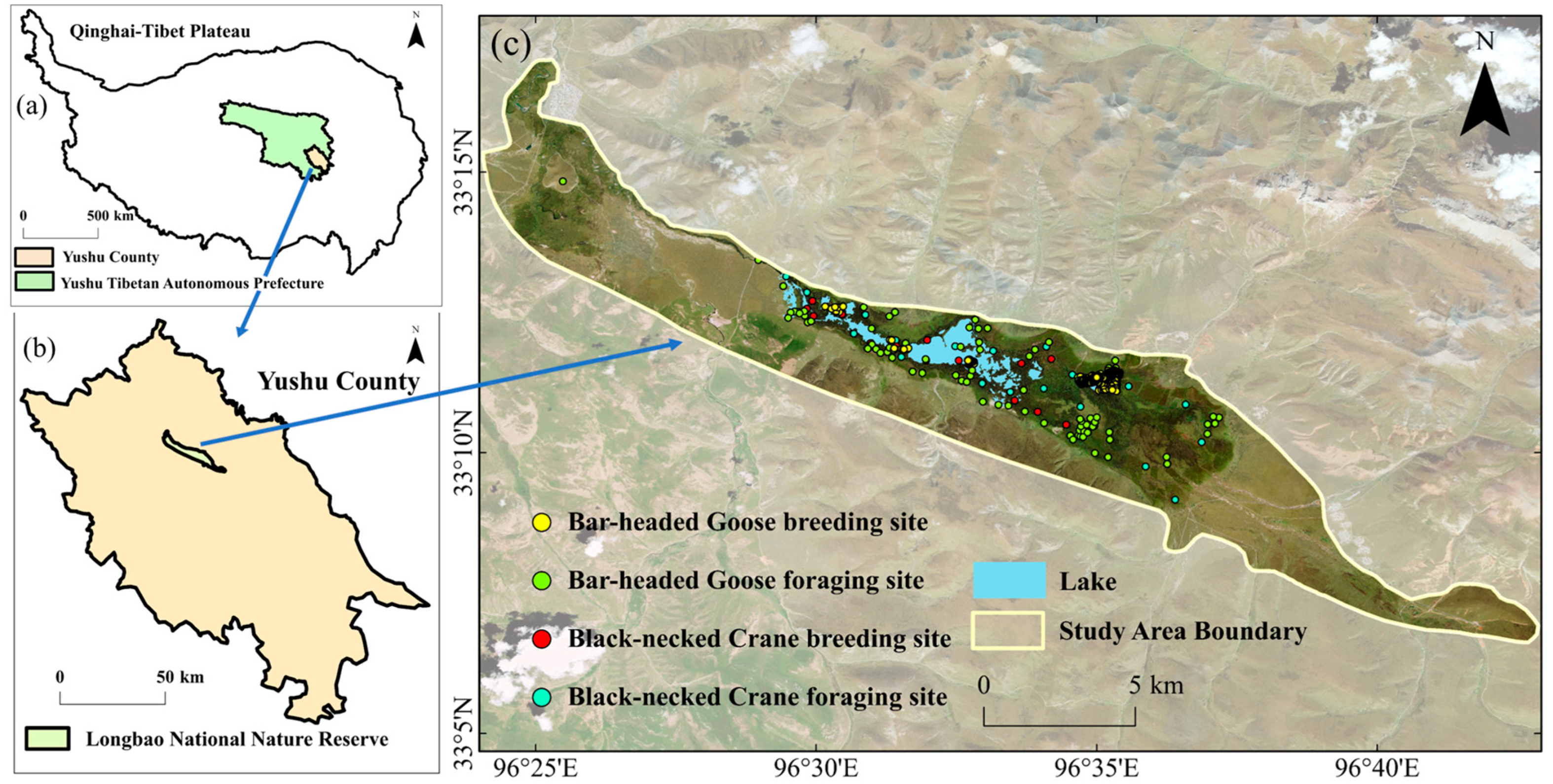

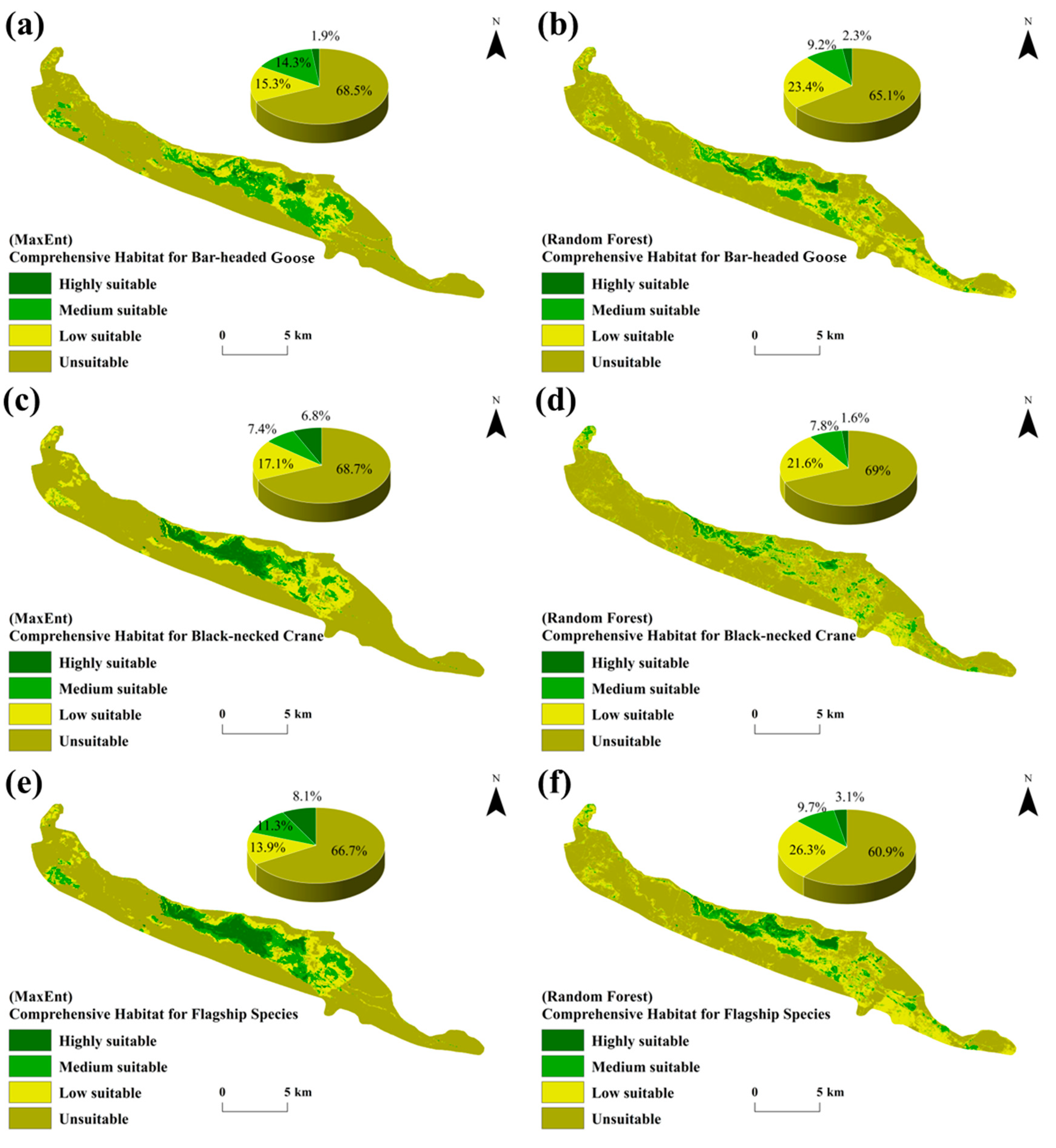
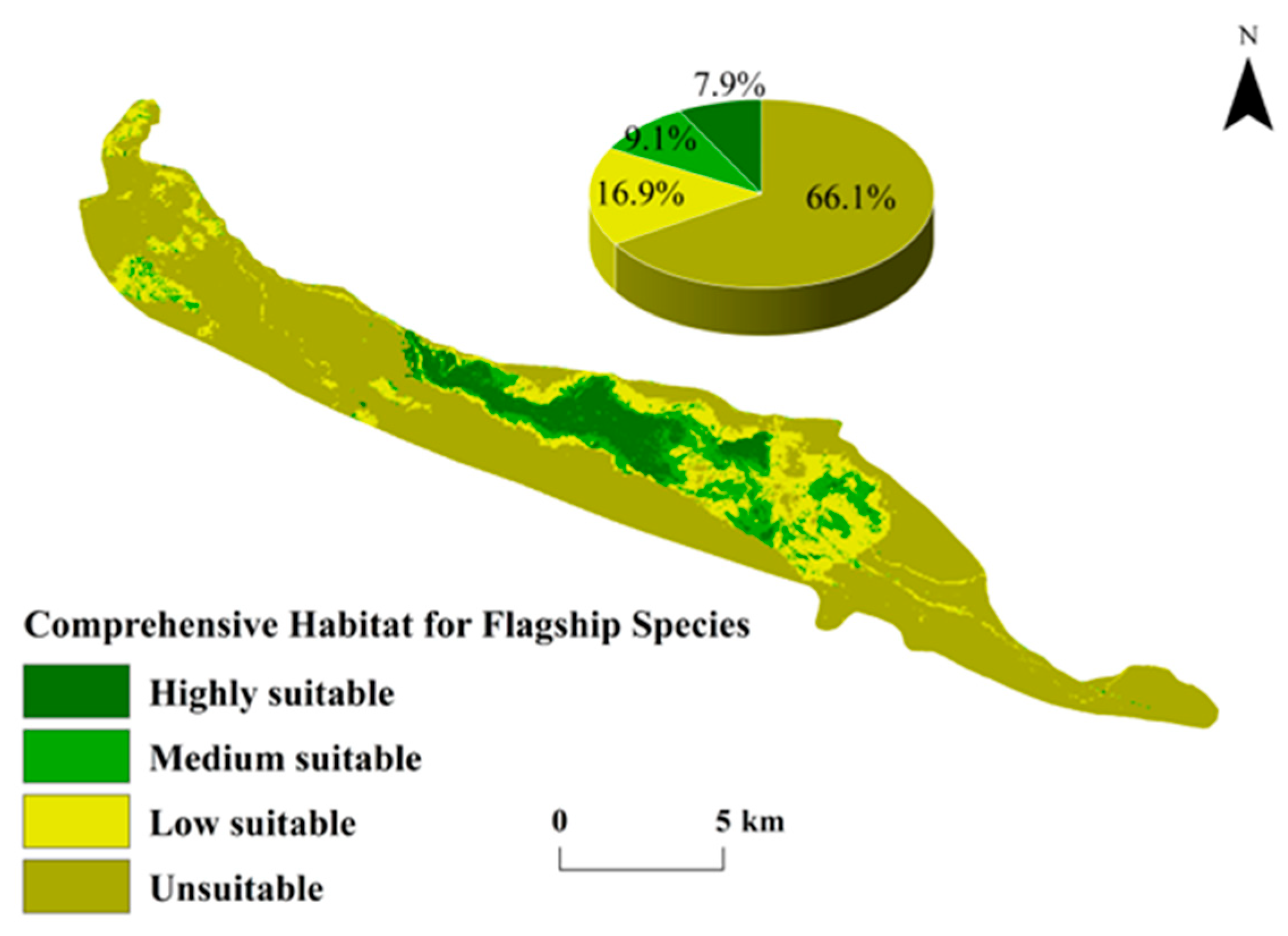


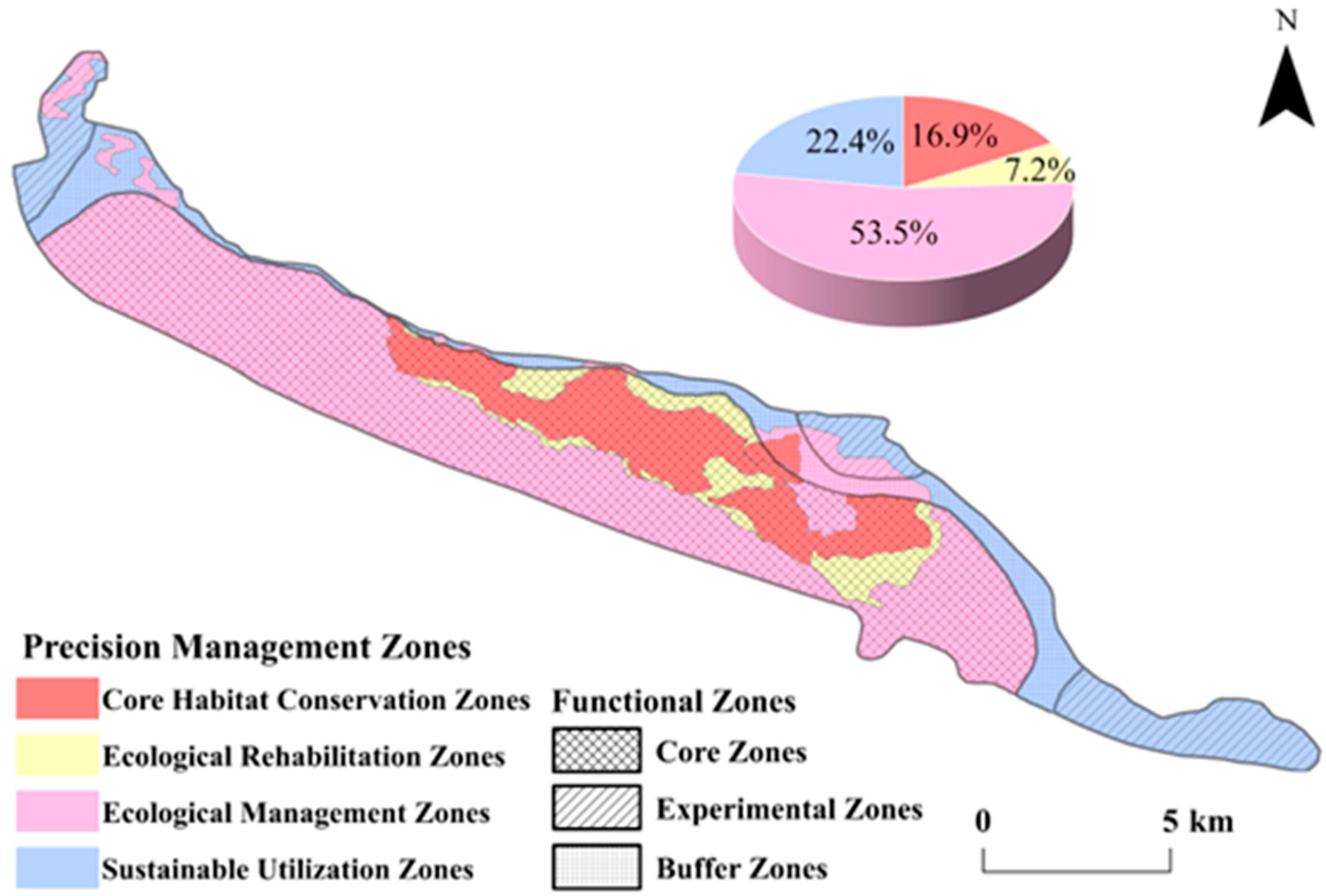
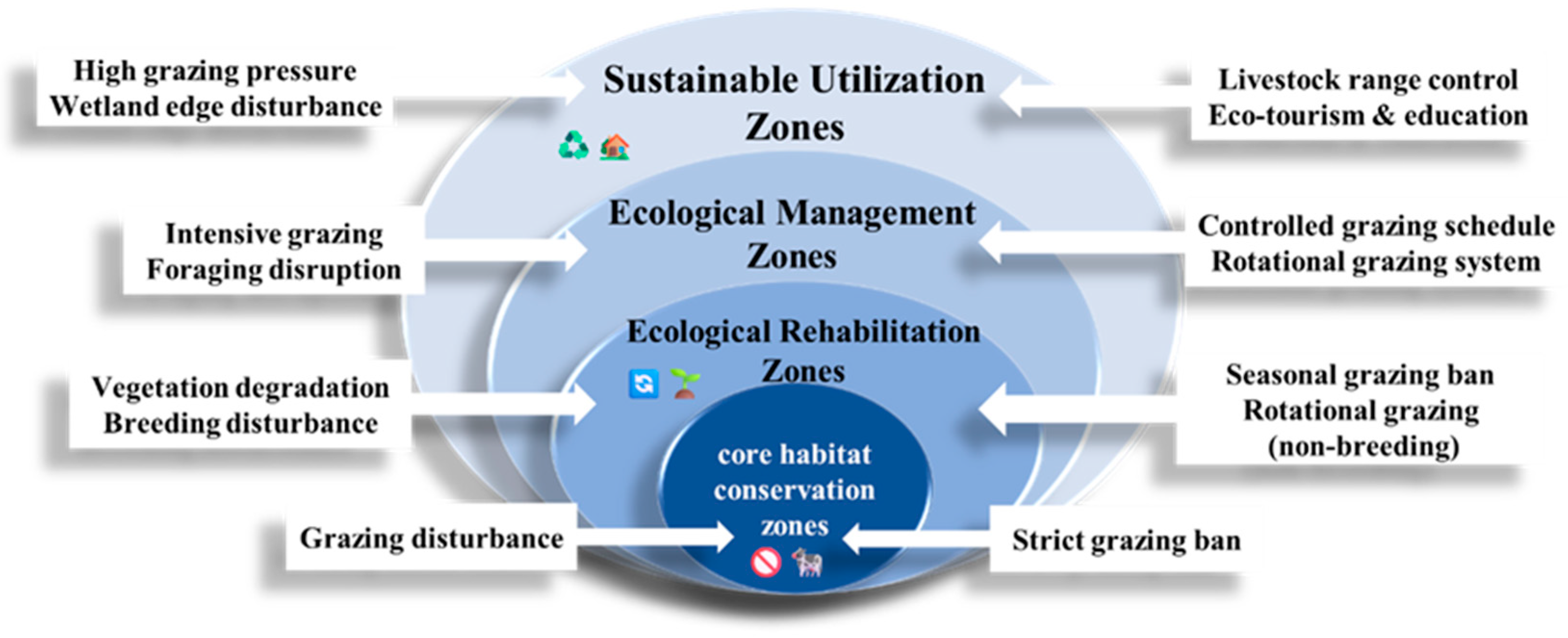
| Category | Description | Code | Spatial Resolution (m) | Year | Source |
|---|---|---|---|---|---|
| Land cover | Land-Use Type | fl | 0.8 | 2023 | GF-2 (CRESDA, https://database.eohandbook.com/database/agencysummary.aspx?agencyID=130, accessed on 16 May 2024) |
| June NDVI | NF | 10 | 2023 | ||
| Vegetation | NDVI-change1 (11–31 March vegetation dynamics) | N1 | 10 | 2023 | Google Earth Engine platform (https://earthengine.google.com/, accessed on 16 May 2024) |
| NDVI-change2 (31 March–8 April vegetation dynamics) | N2 | 10 | 2023 | ||
| NDVI-change3 (8–20 April vegetation dynamics) | N3 | 10 | 2023 | ||
| NDVI-change4 (20 April–13 May vegetation dynamics) | N4 | 10 | 2023 | ||
| NDVI-change5 (13–25 May vegetation dynamics) | N5 | 10 | 2023 | ||
| NDVI-change6 (25 May–15 June vegetation dynamics) | N6 | 10 | 2023 | ||
| Natural environmental | Distance to water | Water | 0.8 | 2023 | GF-2 (CRESDA, https://database.eohandbook.com/database/agencysummary.aspx?agencyID=130, accessed on 16 May 2024) |
| Anthropogenic disturbance | Distance to roads | Road | 0.8 | 2023 | |
| Distance to settlements | Settlement | 0.8 | 2023 |
| Species and Habitat Type | MaxEnt (AUC) | RF (AUC) |
|---|---|---|
| Bar-headed goose breeding site | 0.99 | 0.99 |
| Bar-headed goose foraging site | 0.94 | 0.91 |
| Black-necked crane breeding site | 0.91 | 0.78 |
| Black-necked crane foraging site | 0.96 | 0.70 |
Disclaimer/Publisher’s Note: The statements, opinions and data contained in all publications are solely those of the individual author(s) and contributor(s) and not of MDPI and/or the editor(s). MDPI and/or the editor(s) disclaim responsibility for any injury to people or property resulting from any ideas, methods, instructions or products referred to in the content. |
© 2025 by the authors. Licensee MDPI, Basel, Switzerland. This article is an open access article distributed under the terms and conditions of the Creative Commons Attribution (CC BY) license (https://creativecommons.org/licenses/by/4.0/).
Share and Cite
Ding, Y.; Duo, H.; Zhang, Z.; Zhang, D.; Wei, T.; Cuo, D.; Cairen, B.; An, J.; Huang, B.; Ma, Y. Mitigating Human–Nature Tensions Through Adaptive Zoning Informed by the Habitat Suitability of Flagship Species: Insights from the Longbao Reserve on the Qinghai–Tibet Plateau. Land 2025, 14, 1662. https://doi.org/10.3390/land14081662
Ding Y, Duo H, Zhang Z, Zhang D, Wei T, Cuo D, Cairen B, An J, Huang B, Ma Y. Mitigating Human–Nature Tensions Through Adaptive Zoning Informed by the Habitat Suitability of Flagship Species: Insights from the Longbao Reserve on the Qinghai–Tibet Plateau. Land. 2025; 14(8):1662. https://doi.org/10.3390/land14081662
Chicago/Turabian StyleDing, Yurun, Hairui Duo, Zhi Zhang, Dongxiao Zhang, Tingting Wei, Deqing Cuo, Basang Cairen, Jingbao An, Baorong Huang, and Yonghuan Ma. 2025. "Mitigating Human–Nature Tensions Through Adaptive Zoning Informed by the Habitat Suitability of Flagship Species: Insights from the Longbao Reserve on the Qinghai–Tibet Plateau" Land 14, no. 8: 1662. https://doi.org/10.3390/land14081662
APA StyleDing, Y., Duo, H., Zhang, Z., Zhang, D., Wei, T., Cuo, D., Cairen, B., An, J., Huang, B., & Ma, Y. (2025). Mitigating Human–Nature Tensions Through Adaptive Zoning Informed by the Habitat Suitability of Flagship Species: Insights from the Longbao Reserve on the Qinghai–Tibet Plateau. Land, 14(8), 1662. https://doi.org/10.3390/land14081662





